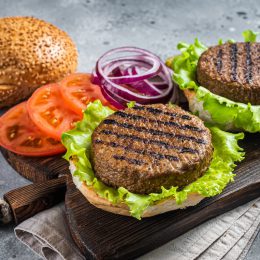12 Tips to Make Your Meal Planning Easier
When it comes to eating well and stressing less, meal planning is one of the best ways to set yourself up for success. Here’s your step-by-step guide.

As the clock approaches 5:00 p.m. each day, do you know what you’re going to have for dinner? Many of us don’t, and that can make mealtimes stressful.
Planning your meals ahead of time can help you avoid the 5 o’clock scramble. It can also help you eat healthier and save money.
If you have a plan for dinner, you’re less likely to fall back on eating out or ordering takeout. And research shows that people who prepare more of their meals at home tend to have a healthier, more nutritious diet.
If you’re not used to planning meals already, it can be hard to get started. Become a meal-planning pro with these 12 steps.
Healthy eating and fitness go together! With SilverSneakers, you can choose from dozens of different Community classes, visit a participating fitness location, or join one of 20+ SilverSneakers LIVE online classes. Check your eligibility here.
Meal-Planning Step #1: Make a Date
We’re not going to lie to you — meal planning doesn’t come together in a flash. To stay committed to the task, set aside time on your calendar to get it done.
First, figure out how often you’ll need to plan meals. This depends on how far in advance you want to plan. You could plan one week at a time or even one month at a time.
Then, find time in your schedule to make it happen. This doesn’t have to be a solo mission. You can get your partner involved or team up with a friend who has a similar healthy-eating goal.
It may sound daunting, but a productive menu-planning session should only take an hour or two.
Meal-Planning Step #2: Don’t Start from Scratch
To save time, keep a generic shopping list on hand that includes things you buy frequently (such as milk, eggs, lettuce greens, chicken). Then add things as you think of them.
Posting a list on the fridge is one way to keep it visible and accessible. This way, you don’t have to start from ground zero every time you sit down for a menu planning session.
For ideas to build your list, here’s How to Stock the Perfect Healthy Kitchen.
Meal-Planning Step #3: Look at the Whole Picture
Many people forget that menu planning is not just for your dinner meals. Be sure to include breakfast, lunch, and even snacks in your plan.
Think about how many complete meals and snacks you’ll need throughout the week and then make a menu and grocery list based on this.
Meal-Planning Step #4: Be Realistic
Meal planning can certainly help you eat out less often, if that’s your goal. But you also want to be realistic when you’re planning out your menu.
Cooking every meal at home for a week or more might be a little too ambitious. Instead, you might work in one or two restaurant meals into your strategy.
Consider your schedule for the week, too. Do you have some busy days when it might be harder to cook at home? Be sure to plan some simple meals that you can whip up quickly on those days.
Meal-Planning Step #4: Shop Your Kitchen First
Before or during your menu planning session, take a look at what you already have in your fridge, freezer, and pantry. Then, look for recipes that can use up that can of beans in the back of your pantry or bag of frozen peas that’s in danger of freezer burn. Shopping your pantry can spark recipe ideas. Plus, it will save you money and prevent food waste.
Recommended reading: 13 Best Foods to Keep in Your Freezer, According to Nutritionists
Meal-Planning Step #5: Plan Based on Expiration Dates
If you’re planning for a week or more in advance, you might need to think carefully about how long fresh food will last. For example, fresh fish and tender greens have a pretty short shelf life. Plan to cook those as soon as you can after your grocery trip. Later on, you can rely more heavily on more shelf stable foods life like eggs, dried lentils, and beets.
Meal-Planning Step #6: Find Inspiration
For recipe inspiration, flip through food magazines and cookbooks or visit food blogs. Social media is also great for finding new recipes. (Tip: Follow us on Instagram at @silversneakers!)
Save recipes however you can. You could make a Pinterest board or bookmark recipes online. Or just jot ideas down on paper or on your phone as you find them. This list will help jump-start your next planning session.
Meal-Planning Step #7: Get Organized
When it comes to writing out your grocery list, try to organize it based on the layout of the grocery store. When you head to the store, you’ll have a clear game plan and won’t waste time backtracking and returning to aisles.
This step will save you time, and it could save you money. The more you walk around the store, the more likely you are to pick up some impulse buys, leading to a bigger grocery bill.
Subscribe to our newsletter
It's quick and easy. You could be one of the 13 million people who are eligible.
Already a member? Click to discover our 15,000+ participating locations.
Follow Us
Meal-Planning Step #8: Put Together the Puzzle
The amount of an ingredient needed for a recipe does not always match the amount that you can buy in the store. If you know you’re going to have leftovers of an ingredient, try to find another recipe that will use the rest.
For example, if one recipe calls for a smaller amount of baby spinach or cilantro, make sure you have another dish that will put these to use. This will help reduce food waste and save significant cash.
Meal-Planning Step #9: Don’t Be Afraid to Go Off Recipe
You don’t always have to follow a recipe to a tee. Making some strategic ingredient subs when needed can be a huge cost- and time-saver.
You can often swap in cheaper ingredients than what’s called for. For example, if you have a pork chop recipe, but chicken breast is on sale this week, you can likely swap the meat in the dish.
You can shop your pantry, too, and swap in things that you already have on hand. For example, don’t buy a new tub of sour cream when the plain Greek yogurt you bought last week is most likely a suitable swap.
Meal-Planning Step #10: Mix it Up
We all have our favorite recipes we go back to again. But to keep your menu interesting and flavorful, try to include a new recipe or two in your menu planning sessions. And keep track of which new recipes are taster-approved and which were a little meh. You might just find some new go-to recipes in the process!
Meal-Planning Step #11: Think Seasonal
As you’re looking through recipes and planning your meals, think about what fresh produce is in season right now. Seasonal produce usually costs less, plus it will taste its best when it’s in season. So is it fresh salad season or hearty soup weather where root veggies will shine?
Meal-Planning Step #12: Pay it Forward
Home-cooked meals can be the gift that keeps on giving. Even if you’re just cooking for one or two people, don’t feel like you can’t try bigger batch recipes. Just save the leftovers for lunch tomorrow. Or package up single servings to freeze so you can have a homemade frozen dinner anytime. Prepping food ahead and planning for leftovers means you won’t have to cook as many days of the week.
See our sources:
Cooking more meals at homes improves health: Public Health Nutrition
Check Your SilverSneakers Eligibility Instantly
SilverSneakers members can go to thousands of gyms and fitness locations across the nation, plus take SilverSneakers LIVE online classes that are designed for seniors of all levels. If you have a Medicare plan, it may include SilverSneakers—at no additional cost. Check your eligibility instantly here.
Not eligible for SilverSneakers? You can still get 200+ free SilverSneakers On-Demand videos and stay in touch with us by creating your online account.





